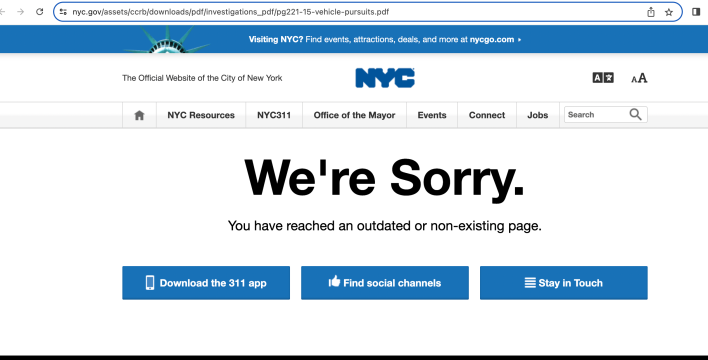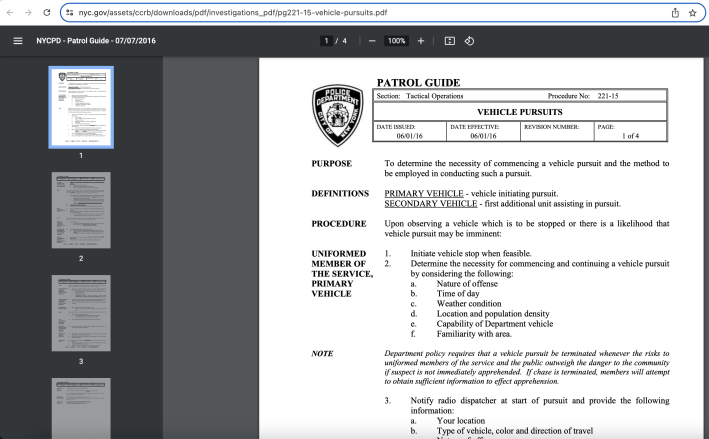The NYPD and its chief watchdog don’t want to know the official policy on police chases

[ad_1]
Good luck finding the NYPD guidelines for high-speed vehicle chases.
The independent agency that investigates police misconduct has removed its copy of the NYPD Patrol Handbook from its website, as it had previously published a copy that included pages about vehicle chases that kept the NYPD hidden from the public — a move that raises concern among legal experts. Amidst a dangerous rise in the number of car chases under Mayor Adams.
The Civilian Complaints Monitor has published a lengthy NYPD report Training manual — including four pages of deleted NYPD vehicle chases Publicly available version — on its website since at least June 1, 2016, however The live link to the entire document has been removed from its website last week after an inquiry from Streetsblog.
A CCRB spokesperson said the oversight agency had revamped its system website months ago, but it was easy to find a link to the unredacted Journals Catalog in a Google search until last week. And now the link is deadand the agency direct visitors To the NYPD website, which contains a copy of the Patrol Handbook without A section on car chases. (The change was first discovered by David Dartley, a longtime Streetsblog reader.)

“The CCRB has spent months combing our website to ensure we are providing the public with the most accurate and up-to-date information. This includes removing old versions of the Patrol Handbook that are no longer applicable and making the current NYPD Patrol Handbook easy to find. When CCRB realized the page removed from our site was still functional, we corrected it.” CCRB made a presentation at the August board meeting notifying the public of the updated site and welcomed public feedback on how to continue to improve the site.
However, the leading civil liberties lawyers are not happy.
Bobby Hodgson, NSW Superintendent Solicitor, said: “It is certainly concerning that a significant part of the journal directory which directly relates to an issue of great public importance … is being actively removed from more accessible versions on public websites.” York Civil Liberties Union.
The removal from the CCRB comes amid numerous reports about the massive increase in NYPD car chases under Adams’ administration — an increase of nearly 600 percent over the same time last year, according to the website. City. The NYPD’s chief of patrol, John Chill, was reportedly behind the increase, as he told several people news outlets The prevalence of ghost cars, illegal scooters and ATVs on the city streets calls for law enforcement. One police chase earlier this month 10 people injuredincluding two children, after a driver of a stolen car pursued by police hit multiple vehicles and pedestrians in Manhattan.
Keegan Stephan, a fellow at Beldock Levine and Hoffman LLC, said the journal directory is a public resource and should remain available online. Sue the NYPD In an unrelated civil rights case.
“It’s very strange,” he said. “It’s also kind of flies in the face of the purpose of the CCRB, it’s supposed to be an entity that exists for accountability. They (NYPD) are clearly in the hot seat of vehicular prosecutions. The CCRB has these records and makes them public. It’s the right thing to do.” (The CCRB said the NYPD decides what will be announced.)
And in 2016, the NYPD amended its patrol manual by placing all procedures related to the use of force in Section 221, or its “tactical operations” series. Vehicle chases are listed under Section 221-15. Prior to that, it was “publicly available for many years” and was previously published in the Journal Directory under section 212-39, according to civil rights attorney Gideon Oliver.
Car chase actions have been updated at least once Since 2016, according to experts and public records. In 2021, NYCLU purchased the 2017 copy sold by a firm then known as Looseleaf Law Publications (now Blue media 360). Hodgson says the company likely obtained the document through a freedom of information request. It is unclear if it has been revised further in the past six years.
But according to an NYPD spokesperson, some pages of the Patrol Handbook were not posted online “due to tactical operational concerns” that could “provide a roadmap for some to interfere with police operations or endanger the lives and safety of officers and/or the public.” “.

Local Law No. 129 of 2016which requires the NYPD to release its evidence, leaves little room for an exemption for certain actions, including “any material that would reveal non-routine investigative techniques or classified information” or “any material, if made public,” that could endanger Salameh. the public or police officers at risk of, or could jeopardize law enforcement investigations or operations.”
Vehicle pursuits “don’t fall into those categories,” says Oliver.
He added, “They reflect the Department’s guidelines on routine policing that are carried out in public and have an enormous – and often very negative – impact on public safety.”
The NYPD claims that the page “related to the vehicular chase was never posted on the public site.”
However, contrary to the NYPD’s claim, other sensitive tactical procedures still exist in the publicly available Patrol Handbook – including the Vehicle Checkpoint Rules (No. 221-16), which is the next page after what should be a vehicular chase.
“It’s strange,” said Shamus Smith, a doctoral lecturer in criminology at the John Jay College of Criminal Justice. “I don’t think it’s smart to continue withholding this information from the general public.”
The NYPD did not respond to multiple follow-up questions about whether the action is under review, or if and when it will be shared publicly again, but legal experts say that no matter how old something is, anything under FOIL is considered public. And it should remain so.
“Maybe they never made it public. It can be discoverable everywhere, like anything on the internet,” said Steve Vaccaro, a lawyer who represents victims of traffic violence. “I’m not against police prosecutions, but there needs to be transparency. It should not be a secret what the police should or should not do.”
Several lawyers told Streetsblog that they remember the procedure being provided to them as part of the litigation, and that it is easy to find with a quick Google search. Indeed, although not fully published, the gist of the procedure is still available as part of the 2018 report. lawsuit against an officer on the NYPD website.
“Nothing there has to be sensitive. It’s been the subject of countless lawsuits over the past two decades. I don’t remember ever being protected or needing any kind of protection,” said Daniel Flanzig, who runs a personal injury law firm. Of secrecy.” “This is very strange… especially in light of what we’ve seen over the past two weeks.”
According to the seven-year-old document previously posted on the CCRB website, the vehicle pursuit policy has remained largely the same, with language similar to wording used in an agency-wide policy. note Department Chief Jeffrey Madre advising them to review current guidance on car chases sent them on August 10.
“A car chase shall be terminated when the danger to service personnel and the public outweighs the danger to the community if the suspect is not apprehended immediately,” according to Madre’s memo, which was reported by the police. mail.
Legal experts remain skeptical of the NYPD’s interpretation.
“It’s clearly a lie as far as CCRB announced it on their website. It’s hard to believe they didn’t know CCRB was available to the public,” Stephan said. “Doing vehicular pursuits is bullshit, warrior cop mentality. There is no reason to go on high speed chases. “
But whether it was posted directly to the NYPD’s website is almost a secondary concern — vehicle chases are rarely, if ever, posted, according to Smith.
“There’s nothing good about chasing after the police. It’s not going to work for anyone. There’s always something that outweighs the cost of going after someone who may have done something wrong and doesn’t want to stop for whatever reason,” he said. “I don’t really see how you can get involved. I don’t see how police prosecutions could endanger people’s lives if they were informed.
[ad_2]
Source link




